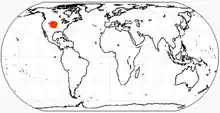| Oxetocyon Temporal range: | |
|---|---|
| Scientific classification | |
| Domain: | Eukaryota |
| Kingdom: | Animalia |
| Phylum: | Chordata |
| Class: | Mammalia |
| Order: | Carnivora |
| Family: | Canidae |
| Subfamily: | †Borophaginae |
| Genus: | †Oxetocyon Green, 1954 |
| Species: | †O. cuspidatus |
| Binomial name | |
| †Oxetocyon cuspidatus Green, 1954 | |
 | |
| Range of Oxetocyon based on fossil distribution | |
Oxetocyon ("beginning dog") is an extinct monospecific genus of the Borophaginae subfamily of canids native to North America. It lived during the Early Oligocene epoch,[1] existing for approximately 2.5 million years. Fossils have been found in Nebraska and South Dakota.
Fossils of Oxetocyon are rare and, as a result, the genus is poorly known, and only the teeth, dentaries, and a fragmentary skull have been reported. The teeth of Oxetocyon indicate a hypocarnivorous diet, as is found in the living raccoon dog, and suggest a potential relationship to the unusual borophagine Otarocyon. Oxetocyon is distinguished from Otarocyon by its own set of dental specializations for an omnivorous diet, particularly by the presence of a cleft that divides each upper molar into front and back halves.[2]
References
- ↑ PaleoBiology Database: Oxetocyon Taxonomy, Species
- ↑ Xiaoming Wang, R.H. Tedford, and B.E. Taylor. 1999. Phylogenetic systematics of the Borophaginae